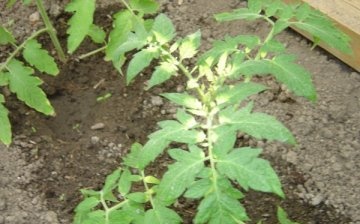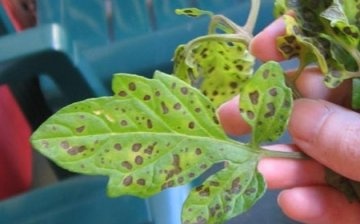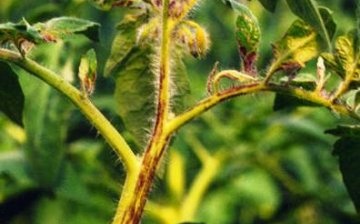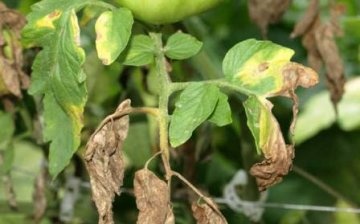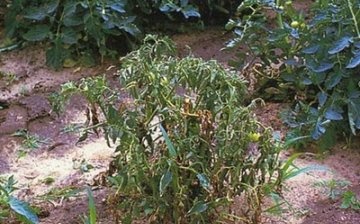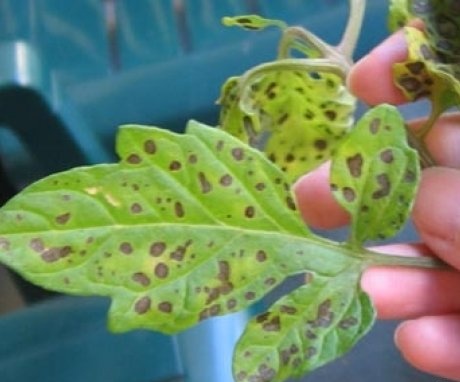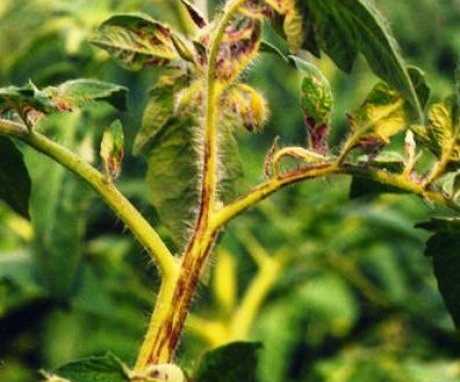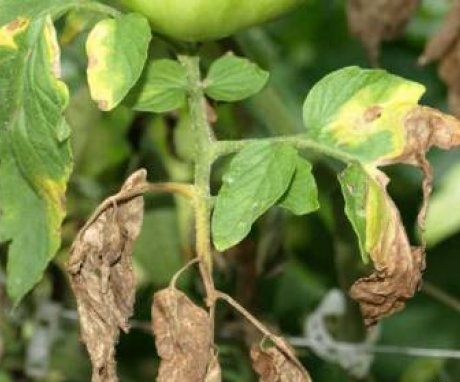Diseases of tomato seedlings: varieties, diagnosis, prevention and treatment
Growing tomatoes on six acres is more than a tradition. This is a cult, the observance of the rituals of which has long and firmly entered the gardening everyday life of summer residents: block the approaches to the windows and occupy the windowsills, seating the young army of green fighters; join the spring parade of the ceremonial export of tomato growth; erect a shelter on the site and correctly place the growing battalion.
And also, get ready for a serious fight, because the enemies are waiting for the tomatoes at every stage of their development. Hordes of pests and infections lie in wait for the plant from the moment the seedlings emerge. Our gardener, of course, cannot be intimidated by such dangers. He will carry out prophylaxis on time and take action at the first symptoms of a tomato disease. And the amateur gardener will approach the question thoroughly - to begin with, he will study the lists of possible diseases and methods of their treatment. Let's figure it out in detail with an important issue.
Content:
Fungal diseases
This group of diseases affects tomatoes most often.
The fungus can cover the seedlings both internally and externally. It parasitizes on the stem and leaves, feeding on plant tissues. It reproduces mainly by spores.
The main diseases caused by the fungus:
- Late blight. The infection is transmitted by seeds of infected plants, through soil, air and raindrops. Phytophthora appears on the leaves in the form of dark spots, framed by a light strip. The stem, becoming striped, gradually dries up and rots in wet weather. If symptoms are found, you should: Isolate diseased shoots. Disinfect the seeds before planting with potassium permanganate for 15 minutes. Add a similar solution to the wells before transplanting seedlings on the basis that for two holes you need to take one gram, diluted in a liter of water. As a preventive measure, spray seedlings with Bordeaux mixture.
- Blackleg... Can infect the plant from the moment of sowing through the soil. The fungus encircles the stem, thinning it, which leads to the death of the shoot. It is important here to carefully prepare the substrate. The soil can be treated with a solution of copper sulfate. Dense sowing of tomatoes should also be avoided. Destroy weak and diseased seedlings before transplanting.
- White leaf spot. The fungus gets on the lower leaves of the seedlings, as a result of which they turn brown, covered with black dots, dry up and fall off. If you notice the disease at the initial stage, then you can try to save the escape by treating it with a solution of Bordeaux liquid. Dead seedlings must be removed immediately, and the substrate must be treated with disinfectants.
- Fusarium wilting. The causative agent is soil fungus. It causes wilting of seedlings due to loss of tissue elasticity, penetrating into the root system of the plant. With a cross section of the stem, the affected vascular bundles covered with brown rings will be clearly visible. It is important here to provide adequate lighting for the seedlings. Tools, substrate, containers must be sterile clean before planting.
Fungal diseases include various types of rot.
The most common ones are:
- Black.
- Gray.
- White.
The methods of plant treatment in this case are as follows:
- Seedlings are sprayed with copper oxychloride.
- Timely remove dead leaves.
- Fertilize the soil trichodermine one week before the intended planting.
Thus, it is possible to reduce the risk of infection of seedlings with fungal diseases by paying increased attention to pre-planting preparation, the key point of which is disinfection.
Viral diseases
The danger of this type of disease lies in their asymptomatic course. Signs of disease are difficult to notice in the early stages of tomato growth.
The most common causes of occurrence:
- Pests carrying the virus.
- Climatic conditions.
- Purity of the soil.
- Infected seeds.
Here is a list of the most dangerous and common diseases:
- Mosaic. Rod-shaped virus - the causative agent of the disease, most often transmitted at the stage planting seedlings... Dark green leaves are randomly interspersed with light ones, forming a mosaic. They turn yellow, frown, curl and fall off. For prevention purposes, seeds of a year ago are used for planting. Affected seedlings are destroyed, and the remaining seedlings are rescued with a solution of potassium permanganate. Also, shoots are treated with a urea solution.
- Streak. The cause of the disease is the tobacco mosaic virus. Brown streaks appear on the surface of the plants, therefore the disease is also called streaking. Ulcers later form in their place, the plant becomes fragile, and the upper part of the stem dies. Streakiness lowers the yield of tomatoes and adversely affects the quality of the fruit. The main methods of fighting are good preparation before landing.
- Aspermia or seedlessness. The plant begins to retard development and growth. The leaves become smaller, their mottling and deformation are observed. They can be corrugated, and the veins remain underdeveloped. In the future, such seedlings have fewer fruits. They are small in size, modified in shape. And most importantly, they lack seeds. Obviously, the disease can be noticed only at a late stage of development.
The causative agent of the disease is the tomato aspermia virus, which is not transmitted through seeds, but dangerous when in contact with infected plants.
Fighting viral diseases is difficult. Complex measures are of a preventive nature. Maintaining optimal conditions for growing seedlings and maintaining cleanliness is important.
Here are the steps to take:
- Spatial isolation of the plant. Planting seedlings away from previous planting sites.
- Fight against harmful insects. Planting crops that prevent the reproduction and migration of aphids and other vectors of infection.
- Weed control. Maximum soil cleansing, removal of plants that spread and accumulate viruses.
- Meticulous processing of containers for planting, greenhouses.
Bacterial diseases
Bacterial diseases are another large group of possible attacks on tomato seedlings.
The main areas of struggle:
- Treatment of planting material with insecticides
- Antibiotic use
- Increasing the immunity of shoots.
Common diseases of this type:
- Black bacterial spot. Disease dangerous for seedlings is introduced through soil and seeds. The causes are destructive humidity and heat. The leaves are covered with black watery spots. Elongated strokes and dots of the same black color are formed on the stems. The bacteria can remain on the seeds for up to a year. The insidiousness of the disease is that the seedlings look absolutely healthy in appearance, while the seeds are infected with bacteriosis. So, it is important to purchase high-quality healthy seeds from trusted producers.
In humus, the infection persists for a long time and also becomes a source of plant infection.
- Brown leaf spot.On the outside, the leaves are covered with gray and yellow spots, on the inside, a bloom of olive shade forms. If the air in the room is too humid, and watering is plentiful, then the disease affects the shoots with lightning speed. The methods of struggle are the same: disinfection of the soil, destruction of diseased plants. Sometimes timely spraying with a fungicide, which contains copper, helps.
- Stolbur. The source of infection is microplasma bodies reproduced by insect vectors. Stolbur is one of the most common ailments. Leaves and stems of seedlings become pink and purple, shrink and coarse.
- Bacterial mottling. The causative agent is a phytopathogenic bacterium.
The main problem in the treatment of bacterial diseases is the lack of effective antibiotics.
Diseases of a non-infectious nature
In addition to the listed groups of diseases, there are less obvious, but relevant reasons for the problems of growing tomatoes. They are associated with an imbalance in mineral nutrition. This type of disease is a consequence of metabolic disorders. Here we are talking not only about the lack of essential nutrients, but also about the balance of minerals in general.
Deficiency reasons may be features of soil compositionpreventing the splitting and absorption of useful elements, violation of the landing technology.
Here is a list of the main problems:
- Lack of calcium. Reasons: a small volume of the substrate, the absence of an important element in mineral feeding of seedlings... Symptoms: the leaves are deformed and bumpy, the root system is affected by rot and dies.
- Potassium deficiency. Causes: Excess calcium blocks the normal absorption of potassium. Symptoms: wrinkling of young leaves.
- Glandular chlorosis. Reasons: excessive use of potassium permanganate. Iron deficiency can only occur in some tomato varieties, while others will remain healthy. Signs: the leaves of young shoots turn yellow, and the veins retain their original color.
- Lack of copper. Reasons: the seedling soil is mainly peat. Signs: loss of leaf elasticity, root damage.
- Lack of phosphorus. Reasons: constant cold (the thermometer shows below 11 degrees Celsius). Usually mature plants can be strengthened with a mullein. Doing this with seedlings is strictly prohibited.
- Nitrogen deficiency. Reasons: lack of supplementary lighting of seedlings and their feeding, which is expressed by the pallor of the leaves.
It is important to draw the attention of novice tomato growers to the use of seedlings.
Everyone knows that preferable to feed the shoots chlorine-free mixtures. However, if chlorine is absolutely excluded, then its absence will lead to a violation of water exchange. The leaves will begin to droop. To prevent this ailment, all you need to do is add a handful of table salt when watering your seedlings.
So, the scale of the threat to the seedlings of such a popular culture becomes obvious. But, armed with the right information and effective drugs, you can cope with most of the existing diseases.
More information can be found in the video.



